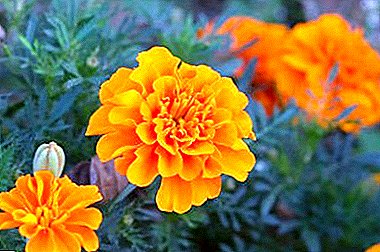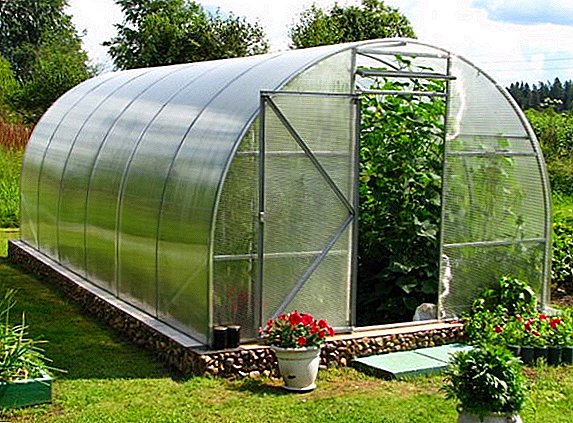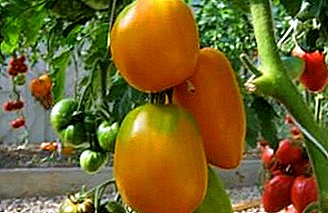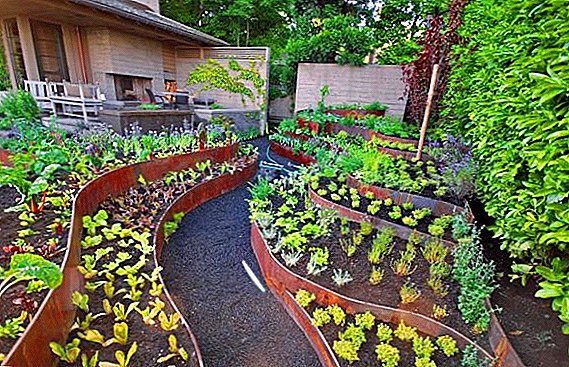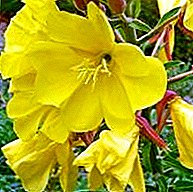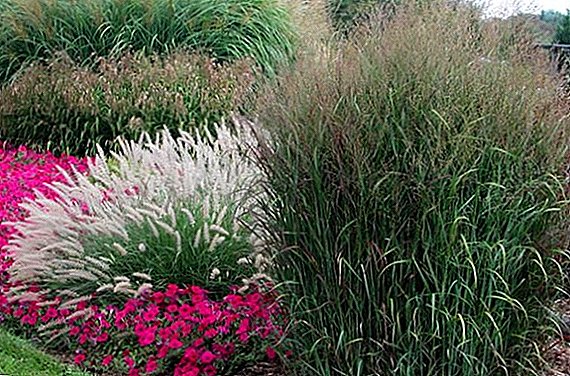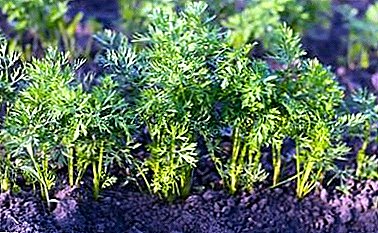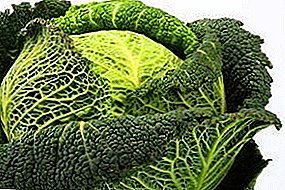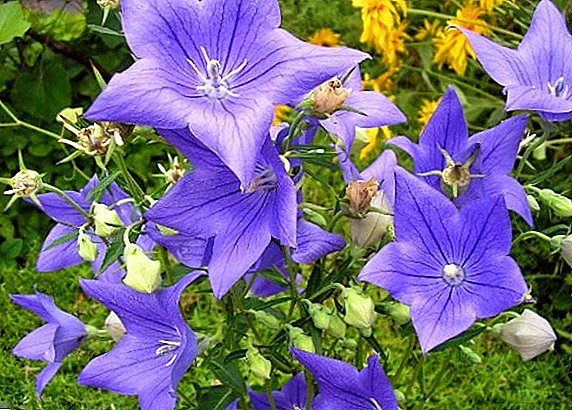 Platicodone (Chinese bell, wide bell) - a long-term representative of the bell family. Flowers are loved by many gardeners with their grace.
Platicodone (Chinese bell, wide bell) - a long-term representative of the bell family. Flowers are loved by many gardeners with their grace.
In order to bring newness and freshness to the design of their site, many gardeners want to learn how to properly care for platicodon flowers.
Did you know? Translated from the Greek, the name of this bell means "wide bowl".
Growing platicodone through seedlings
Platicodone is quite suitable for growing from seed to seedlings, even beginner growers.
Terms for sowing seedlings
It is often practiced to sow the seeds of a crop directly in open ground, in spring or in winter, but it is safer to grow seedlings anyway. The optimal time when you can plant platicodone seeds will be the second half of February - the first half of March.
Presowing seed treatment
 In order to prepare the planting material, you need to pour it into a gauze bag and put it in a bowl of water, leave it for two days. During this time, the contents of the bag swell. After that, the platicodone for sowing seeds is ready.
In order to prepare the planting material, you need to pour it into a gauze bag and put it in a bowl of water, leave it for two days. During this time, the contents of the bag swell. After that, the platicodone for sowing seeds is ready.
Soil and capacity for seedlings
For growing seedlings of culture suitable universal soil mixture for flowering plants. They consist of humus, peat and sand mixed in equal parts. Before laying the seeds, the ground must be loosened.
You can use boxes for planting, wide pots, special containers for seedlings and other suitable containers.
Platicodone sowing for seedlings
Experts recommend 2 methods of sowing platicodone for seedlings:
- placement of seeds directly on the soil surface;
- embedding seeds into the ground to a depth of 4-5 mm, after which they should be lightly sprinkled with sand.
Care and conditions for crops
 After sowing, the soil must be carefully sprayed with settled water at room temperature. Next, moisten the soil as needed when the top layer is completely dry. The containers with platicodone are covered with a film and taken to a warm room (air temperature is 20-23 ° C). Shoots will appear in 10-15 days.
After sowing, the soil must be carefully sprayed with settled water at room temperature. Next, moisten the soil as needed when the top layer is completely dry. The containers with platicodone are covered with a film and taken to a warm room (air temperature is 20-23 ° C). Shoots will appear in 10-15 days.
Care for seedlings of platicodone
Shelter removed from crops as soon as the first shoots appear, and the temperature is reduced to + 18-21 ° C. After each spraying, the ground in the tank must be loosened. When the seedlings appear on 3-4 leaves, they can dive into separate pots (diameter - about 10 mm), in which the seedlings are located before planting in open ground.
Planting of seedlings of platycodone in open ground
Before planting seedlings of platicodone, it is necessary to become familiar with the features of this process.
Terms for planting seedlings in the ground
Platicodone is planted in open ground in the second half of May - the first half of June.
Important! On a flower bed, seedlings can be moved as soon as there is no threat of night frost.
Choosing a landing site
 The plant prefers lit areas, but feels good in partial shade. The soil for platycodone should be fertile, loose, without an excess of moisture and close to the groundwater, well-drained. The best option would be loam mixed with sand, neutral acidity.
The plant prefers lit areas, but feels good in partial shade. The soil for platycodone should be fertile, loose, without an excess of moisture and close to the groundwater, well-drained. The best option would be loam mixed with sand, neutral acidity.
Before planting, a flower bed needs to be dug up and added for every square meter of soil 1 tbsp. l mineral complex fertilizer and 100-150 g of wood ash.
Planting seedlings on the site
Planting seedlings of platicodone is carried out in the following order:
- Dig the required number of holes a little larger volume than the capacity of seedlings.
- Seedlings abundantly watered.
- Ground lump is carefully placed in the hole and covered with earth.
- Moisten the soil under the plant.
Platycodone combination with other plants
Platycodone gets on well with other plants, behaves not aggressively on the garden bed.
Best combined with:
- other perennial bells;
- sage;
- Nivyanik;
- yarrow;
- geraniums;
- phlox.
Features of care for platicodone on the site
Platicodone flower requires proper care in the open field.
Watering, weeding and loosening the soil
 The first 15 days after planting seedlings watering platicodone spend every day. Then the amount of water is reduced, and the soil is moistened no more than 2 times a week. After each watering you need to loosen the soil and, if necessary, weed.
The first 15 days after planting seedlings watering platicodone spend every day. Then the amount of water is reduced, and the soil is moistened no more than 2 times a week. After each watering you need to loosen the soil and, if necessary, weed.
Feeding and mulching between rows
Mulching between rows of platicodone with peat, hay, and humus will help reduce the time for weeding and loosening the soil. Once a month during the growing season and flowering it is worth applying top dressing in the form of any complex fertilizer for flowering crops.
A distinctive feature of the plant is that it can strongly stretch upwards. So that it does not lose its decorative effect, it is periodically pinched or treated with growth retardants (for example, “Athlete”). You can also simply tie the plant to any support.
Pests and Diseases of Platycodone
 Platicodone has good resistance to diseases and pests. Only occasionally can it be affected by gray mold. The treatment consists of additional loosening of the land in the flower bed, reducing watering and removing the affected specimens. The remaining flowers are sprayed with some fungicide. The most commonly used copper sulphate, "Fundazol" (2% solution), "Topsin-M" (1% solution). Apply the dosage recommended by the manufacturer of drugs. If after 7-10 days after treatment the symptoms of gray rot are still noticeable, the procedure should be repeated.
Platicodone has good resistance to diseases and pests. Only occasionally can it be affected by gray mold. The treatment consists of additional loosening of the land in the flower bed, reducing watering and removing the affected specimens. The remaining flowers are sprayed with some fungicide. The most commonly used copper sulphate, "Fundazol" (2% solution), "Topsin-M" (1% solution). Apply the dosage recommended by the manufacturer of drugs. If after 7-10 days after treatment the symptoms of gray rot are still noticeable, the procedure should be repeated.
The main enemies of platicodone can be moles and mice that damage the rhizomes of the plant. The most effective way to deal with these pests is with special chemicals (they fall asleep in holes, lures with poison are placed), a wide range of which can be found in gardening stores.
When to collect and how to store the seeds of platicodone
When the box inside the flower is cracked, and the pedicel is completely dry, the seeds of the platicodone are ripe and ready to be harvested. Usually they are collected in September and stored in dry, warm rooms for no longer than 1-2 years. To do this, you can use canvas bags, glass or tin cans, bags of kraft paper.
Did you know? Seeds of different varieties collected on the plot, when mixed, can give new, unusual shades.
Preparing Platicodone for Winter
Platicodone when grown in the garden requires proper preparation for the winter.
Before the onset of cold weather, the entire ground part should be cut off, leaving only the roots, and the ground should be covered with fallen leaves, peat, hay, sawdust, humus or other material that exists in the farm.
Growing platycodone in a pot
 The plant is suitable not only for planting on the plot, but also for breeding in the home or city apartment. In this case, platicodone is best grown from seed as seedlings for open ground.
The plant is suitable not only for planting on the plot, but also for breeding in the home or city apartment. In this case, platicodone is best grown from seed as seedlings for open ground.
Platikodon in a pot put on a well-lit window sill, but if necessary pritenyuyut, as from direct sunlight bells can get burned. The optimum temperature for platicodone at home is 20 ° C.
Withered flowers should be removed immediately, and the soil should be loosened from time to time. A flower in a pot does not tolerate excessive moisture and high humidity, and therefore needs moderate watering, in winter - at a minimum. Also at this time, the plant is transferred to a cooler room (13-15 ° C).
Important! The amount of water for the pot in the cold season is halved.Spray the plant is not necessary. Before the appearance of bluebells, it is desirable to feed the culture with mineral fertilizer for flowering plants. Since September, the foliage in the flowerpot gradually changes its color from green to crimson, and platicodone retains its decorative appearance. In the spring overwintered plant needs a transplant.


